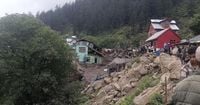Tragedy struck the remote Himalayan region of Kashmir on August 14, 2025, when a sudden cloudburst unleashed devastating flash floods upon Chasoti village, a key stop on a popular Hindu pilgrimage route in the Kishtwar district. What began as a day of religious devotion quickly turned into a desperate struggle for survival, as at least 32 to 33 people were confirmed dead and nearly 200 more were reported missing in the wake of the disaster, according to multiple government sources cited by Reuters and the Associated Press.
The village of Chasoti—sometimes referred to as Chositi in local reports—serves as the last vehicle-accessible point for pilgrims journeying to the Machail Mata temple, perched at an elevation of 2,800 meters. Each year, thousands of devotees park their vehicles here before setting out on foot for the final, arduous stretch to the sacred site. But on this fateful day, torrential rains quickly overwhelmed the region, triggering a cloudburst—an intense downpour of more than 100mm of rain within just an hour, as defined by the Indian Meteorological Department. In the steep, mountainous terrain of Kashmir, such cloudbursts can rapidly give way to catastrophic floods and landslides.
"The news is grim and accurate, verified information from the area hit by the cloudburst is slow in arriving," said Jammu and Kashmir chief minister Omar Abdullah, acknowledging the confusion and chaos that reigned in the immediate aftermath. The scale of destruction became painfully clear as villagers and local public workers recovered the bodies of seven people from a swollen stream and managed to rescue nearly 60 others, according to Susheel Kumar Sharma, a government official on the scene. Yet, with dozens of vehicles and motorbikes swept away and makeshift shops and community kitchens for pilgrims obliterated, the full extent of the tragedy was still unfolding.
Television footage captured the harrowing moments as floodwaters surged through the village, leaving pilgrims weeping in fear and disbelief. The disaster struck with such force and swiftness that many found themselves with little time to react. According to Mohammed Irshad, a top disaster management official quoted by the Associated Press, rescue teams managed to bring at least 100 people to safety as they scoured the devastated area. However, initial estimates suggested that at least 50 others remained unaccounted for, underscoring the urgent need for continued search and rescue efforts.
Federal deputy minister for science and technology Jitendra Singh described the flood as having the potential for "substantial casualties," noting that the region's rugged terrain and ongoing inclement weather made rescue operations especially challenging. "Rescue teams were finding it hard to reach the village due to bad weather," Singh explained, adding that the main road had been washed away and that helicopter access was impossible under the circumstances. The logistical hurdles only compounded the heartbreak for families waiting anxiously for news of their loved ones.
Lieutenant governor Manoj Sinha, the top administrator of Kashmir appointed by New Delhi, extended his condolences to the families of those lost in the disaster. He also emphasized the coordinated response underway: "Personnel from India's military, paramilitary, police and disaster management agencies have been directed to strengthen rescue and relief operations." The scale of the mobilization reflected the gravity of the situation, as authorities raced against both time and the elements to locate the missing and provide aid to survivors.
Indian Prime Minister Narendra Modi weighed in on the tragedy, assuring the nation that "the situation is being monitored closely." In a message posted on X (formerly Twitter), Modi stated, "Rescue and relief operations are underway. Every possible assistance will be provided to those in need." His comments echoed the resolve of local and federal officials to do everything possible to mitigate the disaster's impact, even as the region braced for further weather-related challenges.
The cloudburst that triggered these floods is part of a worrying trend in India's Himalayan regions. The Indian Meteorological Department warns that such events—characterized by extraordinarily heavy rainfall in a short period—are becoming increasingly common. The combination of steep terrain, fragile infrastructure, and growing numbers of pilgrims and residents in these areas means that the human cost of such disasters can be especially high. Flash floods and landslides often follow, leaving devastation in their wake and complicating rescue and recovery efforts.
For the people of Chasoti, the disaster was compounded by the loss of essential community infrastructure. Villagers reported that the floodwaters not only claimed lives and property but also swept away the makeshift shops and community kitchens set up to serve the influx of pilgrims. These facilities are a lifeline for travelers, providing food, shelter, and basic supplies during their journey to the Machail Mata temple. Their destruction left both locals and visitors even more vulnerable in the immediate aftermath of the flood.
As the days wore on, the focus shifted from immediate rescue to the daunting task of accounting for the missing and supporting survivors. The emotional toll was evident as families searched for loved ones and volunteers worked alongside official agencies to provide whatever comfort they could. The tragedy has also reignited conversations about the vulnerability of mountain communities in the face of increasingly erratic weather patterns, with experts calling for improved forecasting, better infrastructure, and more robust disaster preparedness measures.
Yet, amid the sorrow and loss, stories of resilience and solidarity emerged. Villagers, often the first responders in such crises, played a crucial role in rescuing trapped neighbors and offering shelter to the stranded. Local public workers, too, braved treacherous conditions to recover bodies and coordinate relief efforts, demonstrating the strength and compassion that can arise in the darkest of times.
The full impact of the Chasoti flash flood will take time to assess. With dozens still missing and the threat of further rain looming, authorities remain on high alert. But for those who survived—and for the families of those lost—the disaster is a stark reminder of both the beauty and the danger of life in the Himalayas. As the region mourns, calls for greater attention to the risks facing mountain communities grow louder, underscoring the need for sustained support and vigilance in the face of nature's unpredictability.
As rescue and relief operations continue, the people of Kashmir look to the future with a mixture of grief and determination, hoping that lessons learned from this tragedy will help prevent similar losses in the years to come.




